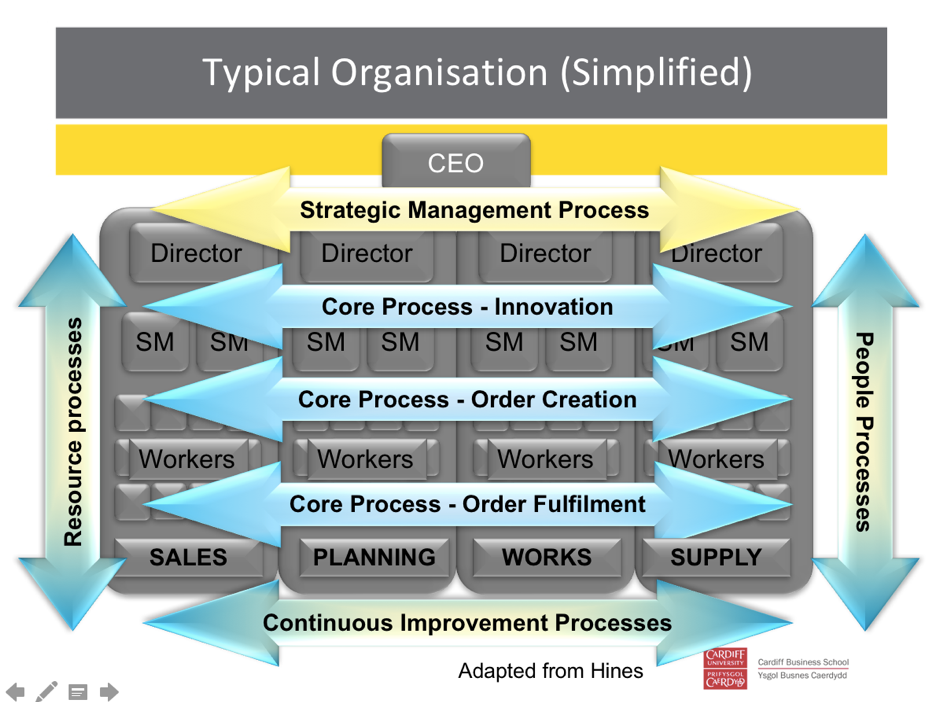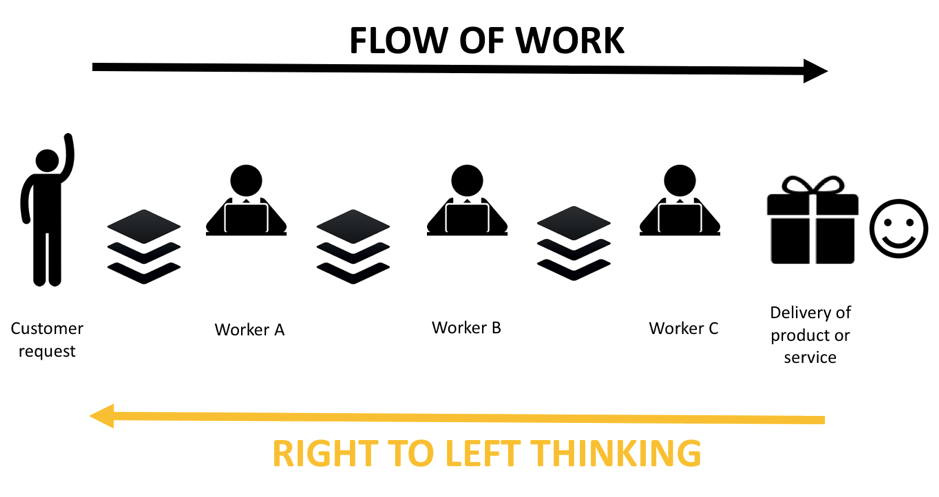Right to Left Technology Thinking
23 March 2018One of the first things I learned when I joined the Lean Enterprise Research Centre (LERC) in 2005 was the power of understanding that, as work is completed in organizations, it moves horizontally across functions and departments. A strange thing to say perhaps, but prior to that point I’d had job after job where (I latterly realized) all I ever knew was my own role. I had no idea about what happened around me. The first job I had after university was at the National Insurance Contributions Office. Every day, a pile of files would magically appear at the end of our team’s table. Our job was to work through these, ringing the people therein to ascertain whether they owed any money, and if they did to arrange a payment plan. We were called the ‘Non-Contact Team’ because the organization had, thus far, been unable to contact these people. (I always thought our name was very strange.) It turned out it was actually surprisingly easy to contact people. Generally, they were able to say that either they were or weren’t self-employed in the period in question. If they weren’t self-employed, they had to send in a letter confirming this, and if they were, then we had a conversation about how much they could pay each month.
Job satisfaction came from my ability to turn calls with slightly aggressive builders from Stoke into polite and considerate telephone conversations, where we agreed a suitable repayment plan. I wrote down the details of what we arranged, closed the file and put it in the out tray. To this day, I have no idea whether any of those people actually paid or what happened when people said they didn’t owe anything. My ability to really understand my job was severely limited as a result. As a consequence, so was my capacity to get better at doing it.
So when I started to participate in cross-functional teams as part of service improvement projects in my new role at the LERC, for the first time I understood just how little I had known in previous jobs. I thought back to my first job and realized how much everything could have been improved if I had known how those files reached me and what happened after my role in the chain. Project after project, from the new perspective of a ‘facilitator’ of improvement, I would see how this experience was commonplace. Whether we were looking at the process of recruiting new members of staff, or how blood samples were collected by doctors, taken to hospitals for analysis and results returned to patients, I realized that people rarely looked beyond their own area of expertise. Not enough time was spent focusing on ‘following’ the work – really understanding how the work gets done as part of an end-to-end process.
When teaching service improvement, I do my best to remember what a revelation this simple truth was and how our service improvement tools can help. One of the key tools that improvement specialists have are ‘maps’. These offer a variety of visual ways to understand how the work flows across departments, from initial order to customer delivery. As part of every mapping session I’ve ever led, there will always be some kind of interjection along the lines of “I wondered why I had to do that?” or “why do you do that when I do that as well?” Just the act of discussing how the work moves from one employee to another will inevitably identify opportunities for improvement. It really is remarkable.
One of my favourite pictures I use to continue conversations around this theme is the following one, which I’ve adapted from Professor Peter Hines. It helps groups think about work as it flows, rather than their own functional departments, such as sales or operations. It groups the different types of workflow as either 1) creating orders, 2) fulfilling those orders or, critically, 3) innovation processes that create new products and/or services. Organizations that have poorly-defined process flows in these areas (processes that don’t have a power in themselves, but rather just ‘happen’) will be unlikely to glean the maximum efficiencies and effectiveness possible.

What’s also important is that the organization recognizes strategic management as a process that affects every part of the business, and that ‘People’ processes such as HR and ‘Resource’ processes including Finance and IT should be enabling of the three core processes and, as such, be subservient to them.
That statement is not meant to lessen or demean the role that technology can have in the success of an organization. Far from it – technology’s positive influence can benefit every part of the above picture. It is, however, essential that the application of technology is the silver thread, or glue, that follows the work horizontally. Trouble comes when technology creates solutions that are insensitive to the flow of work between customer and delivery of a service or product.
Technology should not just flow horizontally, it also needs to flow ‘right to left’ from the customer. A colleague at Nestlé used to call this ‘Right to Left Thinking’ – in other words, not only thinking about work as a horizontal flow across different departments and people, but also that this flow should be thought about first from a happy customer’s perspective. The lens of improvement then tracks back, right to left, across departments to deliver that value.

I’ve found that introducing such concepts to teams can be very useful, so ask yourself, when was the last time you and your colleagues all worked together to analyse the flow of work, right to left? If it’s been a while, then now’s the time to look at your organization from a different perspective, to see the technological opportunities that exist.
Comments
- Marketing Magic
- What’s My Job Again?
- The Reports Have Gone to Her Head
- Cross Stitch Standards and Creativity
- Hefin David and the Aeroplane Arms
- Hankering for a Handbook
- Window of Light
- Defensive Organising
- McMullin’s Tandem of Co-Production
- The Joy of John Parry-Jones
- The Perils of Disappointment
- The Shield of Shame
- Customer Care and Organisation Innovation
- Hooray for Humanity!
- Angry Lemons
- Double Meanings
- Ticketing Masterplans
- When will it all end …
- Lifetime Loyalty and Taylor Swift
- Looking at Things Differently
- Networking Noodles
- Addicted to Truth
- Designs on Service Design
- The Multiple Joys of Universal Design
- Hungry Cultures
- Event Lean
- The Traffic Analogy
- Moving on Up
- Rosé Cava Revolution?
- Powerpoint Sneaky Lean
- Writing about Writing
- ChatGPT Response: Exploring the Art of Expression: Unveiling the Magic of Writing in the Style of Sarah Lethbridge
- Help to Grow Coldplay Style
- Caring IS Everything!
- Institutional Flapping
- “Just Do the Next Right Thing”
- Trust Thermoclines
- Organisational Tempo
- The Inaugural Lethbridge Customer Service Awards
- Vaccine Lean – The Dawn of the Water Spider
- November 2025 (1)
- October 2025 (2)
- September 2025 (1)
- August 2025 (2)
- July 2025 (1)
- June 2025 (1)
- April 2025 (1)
- March 2025 (2)
- February 2025 (1)
- January 2025 (1)
- December 2024 (1)
- November 2024 (1)
- October 2024 (1)
- September 2024 (1)
- July 2024 (2)
- June 2024 (1)
- May 2024 (1)
- March 2024 (1)
- February 2024 (2)
- December 2023 (2)
- October 2023 (2)
- September 2023 (1)
- July 2023 (3)
- June 2023 (1)
- May 2023 (1)
- April 2023 (1)
- March 2023 (1)
- February 2023 (1)
- January 2023 (1)
- November 2022 (1)
- October 2022 (2)
- August 2022 (2)
- July 2022 (1)
- May 2022 (2)
- April 2022 (1)
- February 2022 (1)
- January 2022 (1)
- December 2021 (2)
- November 2021 (1)
- October 2021 (1)
- September 2021 (1)
- August 2021 (1)
- July 2021 (1)
- May 2021 (2)
- April 2021 (1)
- March 2021 (1)
- January 2021 (1)
- December 2020 (1)
- October 2020 (3)
- August 2020 (1)
- June 2020 (2)
- April 2020 (1)
- March 2020 (1)
- February 2020 (1)
- December 2019 (2)
- October 2019 (1)
- September 2019 (1)
- August 2019 (1)
- July 2019 (1)
- June 2019 (1)
- February 2019 (3)
- October 2018 (1)
- September 2018 (1)
- March 2018 (10)
- April 2016 (1)
- January 2015 (3)
- July 2014 (9)
- September 2013 (1)

1 comment
Comments are closed.